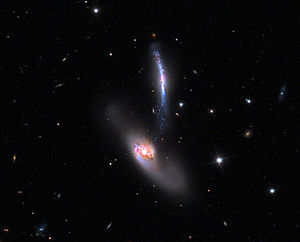NGC 2798
| Galaxy NGC 2798 |
|
|---|---|

|
|
| The galaxies NGC 2798 (right) and NGC 2799 (left) captured by the 81 cm reflecting telescope of the Mount Lemmon Observatory . | |
| AladinLite | |
| Constellation | lynx |
|
Position equinox : J2000.0 , epoch : J2000.0 |
|
| Right ascension | 09 h 17 m 22.8 s |
| declination | + 41 ° 59 ′ 59 ″ |
| Appearance | |
| Morphological type | SB (s) a pec HII |
| Brightness (visual) | 12.0 mag |
| Brightness (B-band) | 13.0 likes |
| Angular expansion | 2.8 ′ × 0.9 ′ |
| Position angle | 160 ° |
| Surface brightness | 12.9 mag / arcmin² |
| Physical data | |
| Redshift | 0.005757 ± 0.000040 |
| Radial velocity | (1726 ± 12) km / s |
|
Stroke distance v rad / H 0 |
(77 ± 6) · 10 6 ly (23.6 ± 1.7) Mpc |
| history | |
| discovery | Wilhelm Herschel |
| Discovery date | January 14, 1788 |
| Catalog names | |
| NGC 2798 • UGC 4905 • PGC 26232 • CGCG 209-045 • MCG + 07-19-055 • IRAS 09141 + 4212 • KUG 0914 + 422A • 2MASX J09172295 + 4159589 • VV 50a • GC 1788 • H II 708 • Part of Arp 283 • spar 117A • KCPG 195A | |
NGC 2798 is a bar-spiral galaxy in the constellation Lynx . It is around 77 million light years away from the Milky Way and forms an interacting pair with NGC 2799 ( Arp 283 ). Halton Arp organized his catalog of unusual galaxies into groups according to purely morphological criteria. This galaxy pair belongs to the class double galaxies with inflow and attraction .
NGC 2798 was discovered on January 14, 1788 by the German-British astronomer Wilhelm Herschel .
Web links
literature
- Jeff Kanipe and Dennis Webb: The Arp Atlas of Peculiar Galaxies - A Chronicle and Observer's Guide , Richmond 2006, ISBN 978-0-943396-76-7
